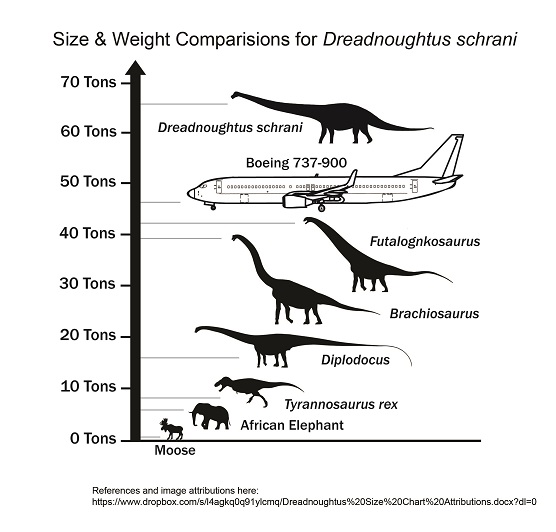2014 Science News: Dreadnoughtus schrani

The herbivores have their say
On Sept. 4, 2014, an announcement in the journal Scientific Reports shook our concept of scale like the thundering footfalls of the ancient reptile there described. The name is no accident. If Dreadnoughtus schrani conjures images of a massive, thickly clad, impenetrable battleship, you are on the right track. Drexel University professor Kenneth Lacovara led the team that spent four years literally uncovering the massive dinosaur, and revealed this Upper Cretaceous vegetarian behemoth's impressive statistics: 85 ft long, 30 ft tall, and weighing about 65 tons; it is the most complete titanosaur sauropod dinosaur skeleton yet discovered, with 70% of its bones intact (skeletons typically present less than 30% of the original bones.) Peek-A-Boo BoneIt all started with a small patch of femur covered with gypsum peeking out at the surface of the earth in what is now the Patagonia region of Argentina. Once uncovered, this femur measured 6 ft in length. Add to that vertebrae 3 ft wide, and topped by a 30 ft weaponized tail, this leviathan was one who truly feared nothing. Teenage TitanosaurThe largest animal alive today, the African elephant, would be absolutely dwarfed by the Dreadnoughtus. In fact, this titanosaur was bigger than 12 African elephants and it probably spent most of its existence 77 million years ago eating non-stop in an effort to support its massive frame. Titanosaur sauropods were plentiful in the southern continents during the final 30 million years of the Mesozoic Era. But this particular specimen seems even more special to us because the scientists determined that this particular Dreadnoughtus was not full-grown. This adolescent dinosaur could eat T. Rex for breakfast—if he weren't a committed herbivore, that is. 3D Imaging Brings Dino to LifeThe heavy lifting done, Dr. Lacovara's self-described mission is to give herbivores their due, using 3D laser scanners to “map“ the mammoth skeleton and digitally spread the news of this exciting discovery of an animal that pushes the frontier of physiology. This paleontologist wants to stamp out the herbivore's wimpy reputation forever: “As opposed to being hapless dimwitted platters of meat in the landscape, as [sauropods are] portrayed a lot of the time, I wanted to portray Dreadnoughtus as this badass animal that deserves a lot of respect.“ |
- More from 2014 News of the World









